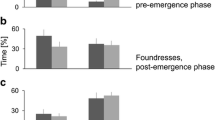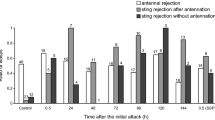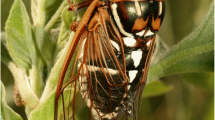Abstract
Behavioural interactions between the solitary koinobiont parasitoid,Venturia canescens, and two of its hosts,Plodia interpunctella andCorcyra cephalonica, were investigated.
The response of both hosts to simulated antennation using a two-haired brush was examined over instars 3 (L3) to 5 (L5). YoungP. interpunctella larvae predominantly adopted escape tactics (writhe, trash) whereas L5P. interpunctella usually froze after the stimulus was applied. L3C. cephalonica larvae were more aggressive (headrear, flick) thanP. interpunctella in response to the application of the stimulus, but olderC. cephalonica responded less aggressively than in earlier instars.
AlthoughV. canescens readily jabbed its ovipositor at both hosts after antennation,P. interpunctella was considerably more susceptible to parasitoid attack thanC. cephalonica, irrespective of size in the final (L5) instar.C. cephalonica, the larger, more aggressive host, actively resisted parasitism whereasP. interpunctella responded much more passively after parasitoid contact. Parasitoids examined and jabbed their ovipositors at dead hosts, but this behaviour was not sustained, implying that host movement stimulates parasitoid attack.
On patches containingV. canescens, L5C. cephalonica andP. interpunctella, mostP. interpunctella larvae responded by freezing after parasitoid contact.P. interpunctella that froze usually avoided parasitism, whereas larvae that attempted to escape by crawling were pursued with vigour byV. canescens and usually parasitized. Irrespective of behaviour after parasitoid contact,C. cephalonia displayed more aggressive behaviour and had much greater success in warding off parasitoid attack.
Host acceptance byV. canescens is clearly affected by the size and species of the host it attacks. The influence of host defensive behaviour is discussed in relation to the evolution of parasitoid counter-defences and oviposition strategies.
Résmé
Les intéractions, sur le plan comportemental, entre le parasitoïde solitaire koïnobionte,Venturia canescens et deux de ses hôtes,Plodia interpunctella etCorcyra cephalonica ont fait l'objet de cette étude. La réponse des deux hôtes à une exploration antennaire simulée à l'aide d'un pinceau à 2 poils différait selon qu'il s'agissait des petites larves du 3e stade ou des grosses larves du 5e stade.
En réponse à ce stimulus, les jeunes larves deP. interpunctella adoptaient principalement un comportement de fuite (en se contorsionnant ou en se débattant) alors que les larves de 3e stade deC. cephalonica se montraient plus agressives (en rejetant la tête en arrière et en donnant des coups de patte). Au stade L5, les larves deP. interpunctella s'immobilisaient après l'application du stimulus, alors que celles deC. cephalonica avaient une réponse moins agressive qu'aux stades précédents.
Alors queV. canescens enfoncait rapidement son ovipositeur dans les 2 hôtes après une exploration antennaire,P. interpunctella était nettement plus sensible à l'attaque du parasitoïde queC. cephalonica, et ce sans tenir compte de la taille du dernier stade (L5).C. cephalonica, l'hôte le plus grand et le plus agressif, résiste activement au parasitisme tandis quePlodia répond de façon beaucoup plus passive au contact du parasitoïde. Les parasitoïdes examinent les hôtes morts et y enfoncent leur ovipositeur, mais les attaques ne sont pas poursuivies et les femelles s'en désintéressent rapidement.
Sur des sites oùV. canescens est en présence de larves du 5e stade deC. cephalonica on deP. interpunctella, la plupart des larves deP. interpunctella répondaient au contact avec le parasitoïde par l'immobilité, alors que les larves deC. cephalonica adoptaient une attitude un peu plus agressive. Les larves deP. interpunctella qui s'immobilisaient échappaient habituellement au parasitisme tandis que celles qui tentaient de fuir étaient poursuivies avec vigueur par le parasitoïde et généralement parasitées. En dépit de leur comportement après le contact,C. cephalonica évitait l'attaque avec plus de succès. L'acceptation de l'hôte parV. canescens est clairement dépendante de la taille et l'espèce de l'hôte qu'il attaque. Le rôle du comportement défensif de l'hôte est discuté en relation avec l'évolution de comportement de contre-défense du parasitoïde et de ses stratégies d'oviposition.
Similar content being viewed by others
References
Allen, G. R. — 1990. Influence of host behavior and host size on the success of oviposition ofCotesia urabae andDolichogenidea eucalypti (Hymenoptera: Braconidae). —J. Insect Behav., 3, 733–749.
Arthur, A. P. — 1981. Host acceptance by parasitoids. In: Semiochemicals (D.A. Nordlund, R.L. Jones &W.J. Lewis, eds). —Wiley and Sons, London, 97–120.
Askew, R. R. &Shaw, M. R. — 1986. Parasitoids communities: their size, structure, and development. In: Insect parasitoids (J. K. Waage &D. Greathead, eds). —Academic Press, London, 225–264.
Barbosa, P., Saunders, J. A. &Waldvogel, M. — 1982. Plant-mediated variation in herbivore suitability and parasitoid fitness. In: Proceedings of the 5th International Symposium of Insect-Plant Relationships (J. H. Visser &A. K. Minks, eds). —Pudoc, Wageningen, 63–71.
Begon, M., Sait, S. M. &Thompson, D. J. — 1995. Persistence of a parasitoid-host system: refuges and generation cycles? —Proc. R. Soc. Lond. B, 260, 131–137.
Calvert, D. J. &van den Bosch, R. — 1972. Behavior and biology ofMonoctonus paulensis (Hymenoptera: Braconidae), a prasite of dactynotine aphids. —Ann. Entomol. Soc. Am., 65, 773–779.
Cornell, J. C., Stamp, N. E. &Bowers, N. E. — 1987. Developmental change in aggregation, defense and escape behavior of buckmoth caterpillars,Hemileuca lucina (Saturniidae). —Behav. Ecol. Sociobiol., 20, 383–388.
Cox, P. D. & Bell, C. H. — 1991. Biology and ecology of moth pests of stored foods. In: Ecology and management of food industry pests (J. R. Gorham, ed.). —FDA Technical Bulletin, Virginia, 181–193.
Dial, C. I. &Adler, P. H. — 1985. Larval behavior and cannibalism inHeliothis zea (Lepidoptera: Noctuidae). —Ann. Entomol. Soc. Am., 83, 258–263.
Doutt, R. L. — 1964. Biological characteristics of entomophagous adults. In: Biological control of insect pests and weeds (P. DeBach, ed.). —Reinhold, N. Y., 145–167.
Fisher, R. C. — 1959. Life history and ecology ofHorogenes chrysostictos Gmelin (Hymenoptera, Ichneumonidae) a parasite ofEphestia sericarium (Lepidoptera: Phycitidae). —Can. J. Zool., 37, 429–446.
Flanders, S. E. — 1950. Regulation of ovulation and egg disposal in the parasitic Hymenoptera. —Can. Entomol., 82, 134–140.
Fox, L. R. — 1975. Cannibalism in natural populations. —Ann. Rev. Ecol. Syst., 6, 87–106.
Gardner, S. M., Ward, S. A. &Dixon, A. F. G. — 1984. Limitation of superparasitism byAphidius rhopalosiphi, a consequence of aphid defensive behaviour. —Ecol. Entomol., 9, 149–155.
Gauld, I. D. — 1988. Evolutionary patterns of host utilization by ichneumonoid parasitoids (Hymenoptera: Ichneumonidae and Braconidae). —Biol. J. Linn. Soc., 57, 137–162.
Gerling, D., Roitberg, B. D. &Mackauer, M. — 1990. Instar-specific defense of the pea aphid,Acrythosiphon pisum: Influence on oviposition success of the parasiteAphelinus asychis (Hymenoptera: Aphelinidae). —J. Insect Behav., 3, 501–514.
Glen, D. M. — 1977. Ecology of the parasites of a predatory bug,Blepharidopterus angulatus (Fall). —Ecol. Entomol., 2, 47–55.
Godfray, H. C. J. — 1994. Parasitoids: Behavioral and Evolutionary Ecology. —Princeton University Press, Princeton, New Jersey.
Gross, P. — 1993. Insect behavioral and morphological defenses against parasitoids. —Ann. Rev. Entomol., 38, 251–273.
Gross, P. &Price, P. W. — 1988. Plant influences on parasitism of two leaf-miners: a test of enemy-free space. —Ecology, 69, 1506–1516.
Harvey, J. A., Harvey, I. F. &Thompson, D. J. — 1994. Flexible larval growth allows use of a range of host sizes by a parasitoid wasp. —Ecology, 75, 1420–1428.
Harvey, J. A. &Thompson, D. J. — 1995. Developmental interactions between the solitary endoparasitoidVenturia canescens and two of its hosts,Plodia interpunctella andCorcyra cephalonica. —Eur. J. Entomol., 92, 427–435.
Herrebout, W. M. — 1969. Some aspects of host selection inEucarcelia rutilla Vill (Diptera: Tachinidae). —Neth. J. Zool., 19, 1–104.
Hopper, K. R. — 1986. Preference, acceptance, and fitness components ofMicroplitis croceipes (Hymenoptera: Braconidae) attacking various instars ofHeliothis virescens (Lepidoptera: Noctuidae). —Environ. Entomol., 15, 274–280.
Jervis, M. A. &Kidd, N. A. C. — 1986. Host-feeding strategies in hymenopteran parasitoids. —Biol. Rev., 61, 395–434.
Jervis, M. A. &Kidd, N. A. C. — 1995. Insect Natural Enemies: practical approaches to their study and evaluation. —Chapman & Hall, London.
Kouame, K. L. &Mackauer, M. — 1991. Influence of aphid size, age, and behaviour on host choice by the parasitoid waspEphedrus californicus: a test of host-size models. —Oecologia, 80, 197–203.
Loan, C. C. — 1964. Observation on the biology ofCentistes excrucians (Hymenoptera: Braconidae). —Proc. Entomol. Soc. Ont., 94, 56–61.
Mackauer, M. &Sequeira, R. — 1993. Patterns of development in insects parasites. In: Parasites and Pathogens of Insects Volume 1 (N. E. Beckage, S. N. Thompson &B. A. Frederici, eds.). —Academic Press, New York, 1–20.
Melton, C. W. &Browning, H. W. — 1985. Life history and reproductive biology ofAllorhogas pyralophagus (Hymenoptera: Braconidae), a parasite improted for release againstEoreuma loftini (Lepidoptera: Pyralidae). —ann. Entomol. Soc. Am., 79, 402–406.
Mueller, T. F. — 1983. The effect of plants on the host relations of a specialist parasitoid ofHeliothis larvae. —Entomol. Exp. Appl., 34, 78–84.
Richerson, J. V. &DeLoach, C. J. — 1972. Some aspects of host selection byPerilitus coccinellae. —Ann. Entomol. Soc. Am., 65, 834–839.
Rogers, D. J. — 1972. The ichneumon waspVenturia canescens: oviposition and avoidance of superparasitism. —Entomol. Exp. Appl., 15, 190–194.
Rotheray, G. E. — 1981. Host searching and oviposition behaviour of some parasitoids of aphidophagous syrphid larvae. —Ecol. Entomol., 6, 79–87.
Salt, G. — 1975. The fate of an internal parasitoid,Nemeritis canescens, in a variety of insects. —Trans. R. Ent. Soc. Lond., 127, 141–161.
Schmidt, G. T. — 1974. Host acceptance behaviour ofCampoletis sonorensis towardHeliothis zea. —Ann. Entomol. Soc. Am., 67, 835–844.
Slansky, F. Jr. — 1986. Nutritional ecology of endoparasitic insects and their hosts: an overview. —J. Insect Physiol., 32, 255–261.
Smilowitz, Z. &Iwantsch, G. F. — 1975. Relationship between the parasitoidHyposoter exiguae and the cabbage looper,Tricholupsia ni: the effect of host age on ovipositional rate of the parasitoid and successful parasitism. —Can. Entomol., 107, 689–695.
Takagi, M. — 1986. The reproductive strategy of the gregarious parasitoid,Pteromalus puparum (Hymenoptera: Pteromalidae). 2. Host size discrimination and regulation of the number and sex ratio of progeny in a single host. —Oecologia, 70, 321–325.
Taylor, A. D. — 1988. Host effects on functional and ovipositional responses ofBracon hebetor. —J. Anim. Ecol., 57, 173–184.
Van Alphen, J. J. M. &Vet, L. E. M. — 1986. An evolutionary approach to host finding and host selection. In: Insect Parasitoids (J. K. Waage &D. Greathead, eds). —Academic Press, London, 23–61.
Vet, L. E. M. &van Alphen, J. J. M. — 1985. A comparative functional approach to the host detection behaviour of parasitic wasps. I. A qualitative study on Eucoilidae and Alysiinae. —Oikos, 44, 478–486.
Vinson, S. B. — 1976. Host selection by insect parasitoids. —Ann. Rev. Entomol., 21, 109–133.
Vinson, S. B. — 1985. The behavior of parasitoids. In: Comprehensive Insect Physiology, Biochemistry and Pharmacology, Volume 9 (G. A. Kerkut &L. I. Gilbert, eds). —Pergamon, New York, 417–469.
Vinson, S. B. &Iwantsch, G. F. — 1980. Host suitability for insect parasitoids. —Ann. Rev. Entomol., 25, 397–419.
Waage, J. K. — 1978. Arrestment responses of the parasitoid,Nemeritis canescens, to a contact chemical produced by its host. —Physiol. Entomol., 3, 135–146.
Waloff, N. — 1967. Biology of three species ofLeiophron (Hymenoptera: Braconidae, Euphorinae) parasitic on Miridae on broom. —Trans. R. Entomol. Soc. Lond., 118, 187–213.
Weseloh, R. M. — 1974. Host recognition by the gypsy moth larval parasitoid,Apanteles melanoscelus. —Ann. Entomol. Soc. Am., 67, 585–587.
Williams, J. R. — 1951. The factors which promote and influence the oviposition ofNemeritis canescens Gravs. —Proc. Roy. Entomol. Soc. Lond. Ser. A., 26, 49–58.
Yeargan, K. V. &Braman, S. K. — 1986. Life history of the parasiteDiolcogaster facetosa (Weed) (Hymenoptera: Braconidae) and its behavioral adaptation to the defensive response of a lepidopteran host. —Ann. Entomol. Soc. Am., 79, 1029–1033.
Yeargan, K. V. &Braman, S. K. — 1989. Life history of the hyperparasitoidMesochorus discitergus (Hymenoptera: Ichneumonidae) and tactics used to overcome the defensive behavior of the green cloverworn (Lepidoptera: Noctuidae). —Ann. Entomol. Soc. Am., 82, 393–398.
Author information
Authors and Affiliations
Rights and permissions
About this article
Cite this article
Harvey, J.A., Thompson, D.J. Host behaviour and its influence on foraging and acceptance by the solitary parasitoid wasp,Venturia canescens (Hym: Ichneumonidae) . Entomophaga 40, 193–210 (1995). https://doi.org/10.1007/BF02373068
Received:
Accepted:
Issue Date:
DOI: https://doi.org/10.1007/BF02373068




